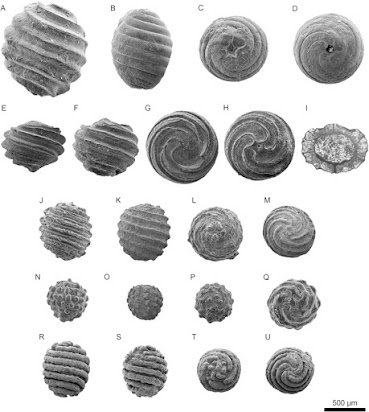Charophyta
Charophyta or Charophytes are a division of green algae with global distribution , algae whose cell walls are encrusted with limestone, which makes them suitable for fossilization. Their vegetative apparatu a few centimeters to a few deci-meters long is formed by a filamentous axis branched into whorls. The stem is formed of very short nodes separated by internodes ,from each node is born a whorl of short branches.
The Charophytes are of the order of Charales and of the Characeae family. The very long history of the Charophytes begins in the Lower Silurian, with the earliest fossils being 425 million years old! Of the 10 families comprising 46 fossil genera, only one family remains, that of the Characeae, comprising 6 genera. These macro-algae take more or less the appearance of submerged horsetails, rooted in the sediment by rhizoids, the size of which varies according to the species from a few centimeters to more than one meter. The determination of Charophytes is mostly limited to the family.
Morphology of the charophyte thallus, an example of Chara rudis is given.
All members of the charophyte group have the same general shape, with a modular structure in nodes and internodes. Whorls of lateral expansions give a look of horsetail ,. The general size varies from 20 cm to over a meter. The internode cells can be very large (up to 25 cm), with walls sometimes heavily calcified.
The reproductive organs are located at the nodes. The female organ is an oogonium surrounded by an envelope made of spiral filaments. After fertilization, the calcified envelope walls persist, giving the seed or gyrogonite its characteristic spiral appearance
Small sized charophyte gyrogonites in the Maastrichtian of Coll de Nargó, Eastern Pyrenees: An adaptation to temporary floodplain ponds
- Polar view of gyrogonite showing spiral cell (Triassic). Bar = 500 pm.
In a favorable environment, they can form real meadows under lacustrine. They are also the last areas of deep vegetation due to their ability to adapt to very low light conditions. The majority of species requiring nutrient poor and clear water to ensure their life cycle, they decline in the event of nutrient pollution.
They are also a source of food for many organisms (aquatic birds, fish, invertebrates) Charophytes are also the subject of much research in paleolimnology and physiology. The calcified "seeds" (called "gyrogonites") constitute valuable microfossils for the reconstruction of paleoenvironments.
Positive gravitropism of the Charophyte algae (a – Chara vulgarisL.intheOrenRiverpool),survivingintheterrestrialhabitat occu pation (b – Chara grovesii B.P. Pal, the Ga'aton River), positive phototropism (c – Chara gymnophylla A.Braun in the Nevoria pool, Nor thern Israel), negative phototropism (d – Chara vulgaris in the Neot Zmadar pool, Southern Negev Desert) .







Comments
Post a Comment